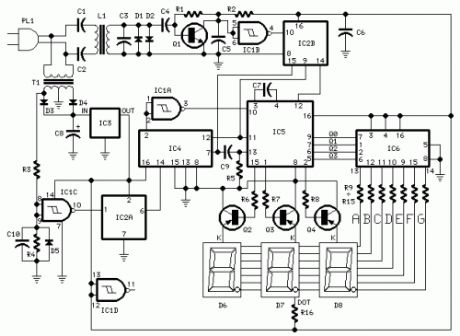Signal Processing
Receiver circuit diagram
Published:2013/7/23 21:20:00 Author:muriel | Keyword: Receiver circuit diagram | From:SeekIC

Receiver Parts:R1 100K 1/4W ResistorR2 1K 1/4W ResistorR3,R4,R6-R8 12K 1/4W ResistorsR5 47K 1/4W ResistorR9-R15 470R 1/4W ResistorsR16 680R 1/4W ResistorC1,C2 47nF 400V Polyester CapacitorsC3,C7 1nF 63V Polyester CapacitorsC4 10nF 63V Polyester CapacitorC5,C6,C10 220nF 63V Polyester CapacitorsC8 1000µF 25V Electrolytic CapacitorC9 100pF 63V Ceramic CapacitorD1,D2,D5 1N4148 75V 150mA DiodesD4,D4 1N4002 100V 1A DiodesD6-D8 Common-cathode 7-segment LED mini-displaysIC1 4093 Quad 2 input Schmitt NAND Gate ICIC2 4518 Dual BCD Up-Counter ICIC3 78L12 12V 100mA Voltage regulator ICIC4 4017 Decade Counter with 10 decoded outputs ICIC5 4553 Three-digit BCD Counter ICIC6 4511 BCD-to-7-Segment Latch/Decoder/Driver ICQ1 BC239C 25V 100mA NPN TransistorQ2-Q4 BC327 45V 800mA PNP TransistorsL1 Primary (Connected to C1 & C2): 10 turnsSecondary: 100 turnsWire diameter: O.2mm. enameledPlastic former with ferrite core. Outer diameter: 4mm. T1 220V Primary, 12+12V Secondary 3VA Mains transformerPL1 Male Mains plug & cable
Device purpose:This circuit is intended for precision centigrade temperature measurement, with a transmitter section converting to frequency the sensor's output voltage proportional to the measured temperature. The output frequency bursts are conveyed into the mains supply cables.The receiver section counts the bursts coming from mains supply and shows the counting on three 7-segment LED displays. The least significant digit displays tenths of degree and then a 00.0 to 99.9 °C range is obtained.Transmitter-receiver distance can reach hundred meters, provided both units are connected to the mains supply within the control of the same light-meter.
Transmitter circuit operation:IC1 is a precision centigrade temperature sensor with a linear output of 10mV/°C driving IC2, a voltage-frequency converter. At its output pin (3), an input of 10mV is converted to 100Hz frequency pulses. Thus, for example, a temperature of 20°C is converted by IC1 to 200mV and then by IC2 to 2KHz. Q1 is the driver of the power output transistor Q2, coupled to the mains supply by L1 and C7,C8.
Receiver circuit operation:The frequency pulses coming from mains supply and safely insulated by C1,C2 & L1 are amplified by Q1; diodes D1,D2 limiting peaks at its input. Pulses are filtered by C5, squared by IC1B, divided by 10 in IC2B and sent for the final count at the clock input of IC5.IC4 is the time-base generator: it provides reset pulses for IC1B and IC5 and enables latches and gate-time of IC5 at 1Hz frequency. It is driven by a 5Hz square wave obtained from 50Hz mains frequency picked-up from T1 secondary, squared by IC1C and divided by 10 in IC2A.IC5 drives the displays' cathodes via Q2,Q3 & Q4 at a multiplexing rate frequency fixed by C7. It drives also the 3 displays' paralleled anodes via the BCD-to-7 segment decoder IC6.Summing up, input pulses from mains supply at, say, 2KHz frequency, are divided by 10 and displayed as 20.0°C.
Notes:D6 is the Most Significant Digit and D8 is the Least Significant Digit.R16 is connected to the Dot anode of D7 to permanently light the decimal point.Set the ferrite cores of both inductors for maximum output (best measured with an oscilloscope, but not critical).Set trimmer R4 in the transmitter to obtain a frequency of 5KHz at pin 3 of IC2 with an input of 0.5Vcc at pin 7 (a digital frequency meter is required).More simple setup: place a thermometer close to IC1 sensor, then set R4 to obtain the same reading of the thermometer in the receiver's display.Keep the sensor (IC1) well away from heating sources (e.g. Mains Transformer T1).Linearity is very good.
Reprinted Url Of This Article:
http://www.seekic.com/circuit_diagram/Signal_Processing/Receiver_circuit_diagram.html
Print this Page | Comments | Reading(3)

Article Categories
power supply circuit
Amplifier Circuit
Basic Circuit
LED and Light Circuit
Sensor Circuit
Signal Processing
Electrical Equipment Circuit
Control Circuit
Remote Control Circuit
A/D-D/A Converter Circuit
Audio Circuit
Measuring and Test Circuit
Communication Circuit
Computer-Related Circuit
555 Circuit
Automotive Circuit
Repairing Circuit
Code: